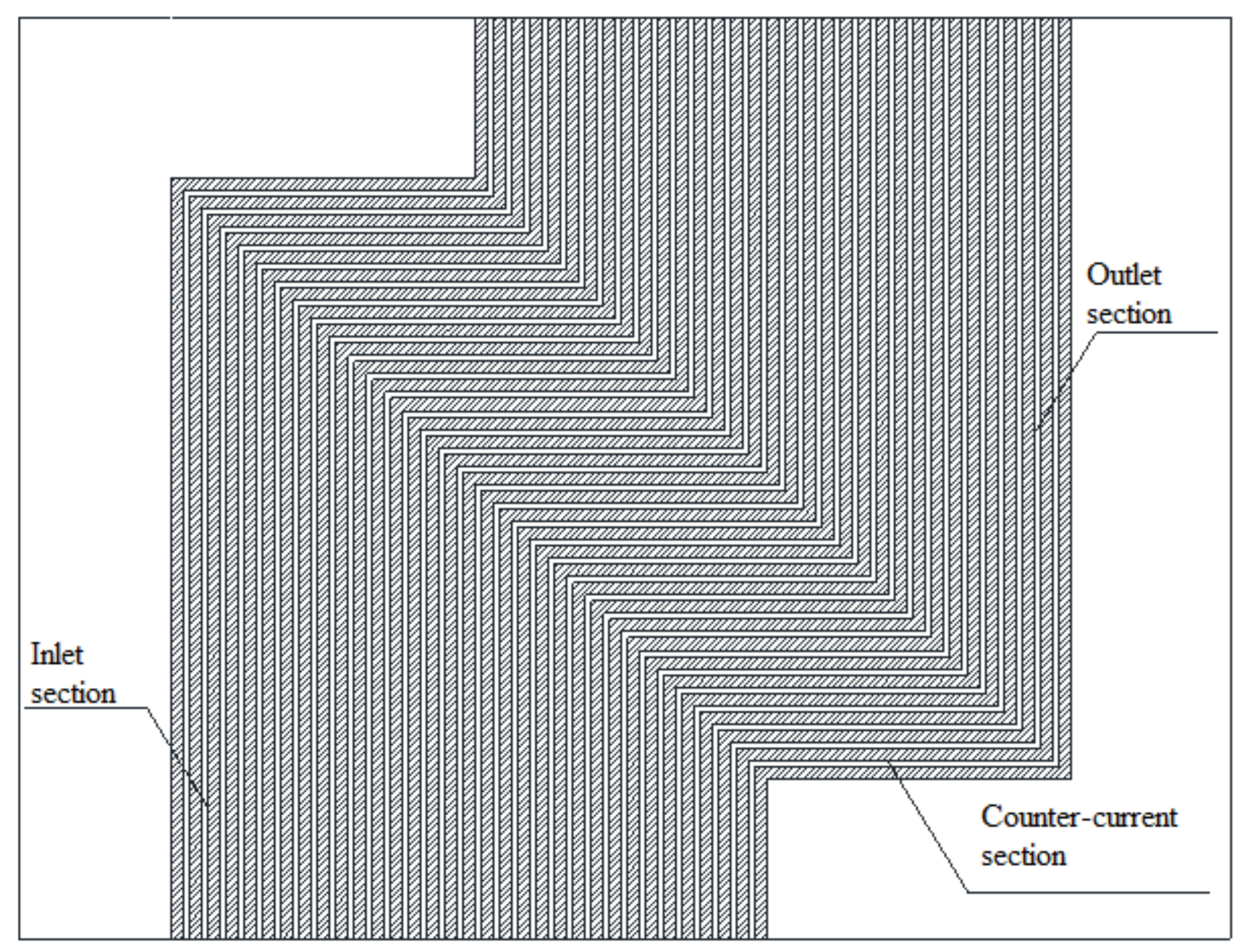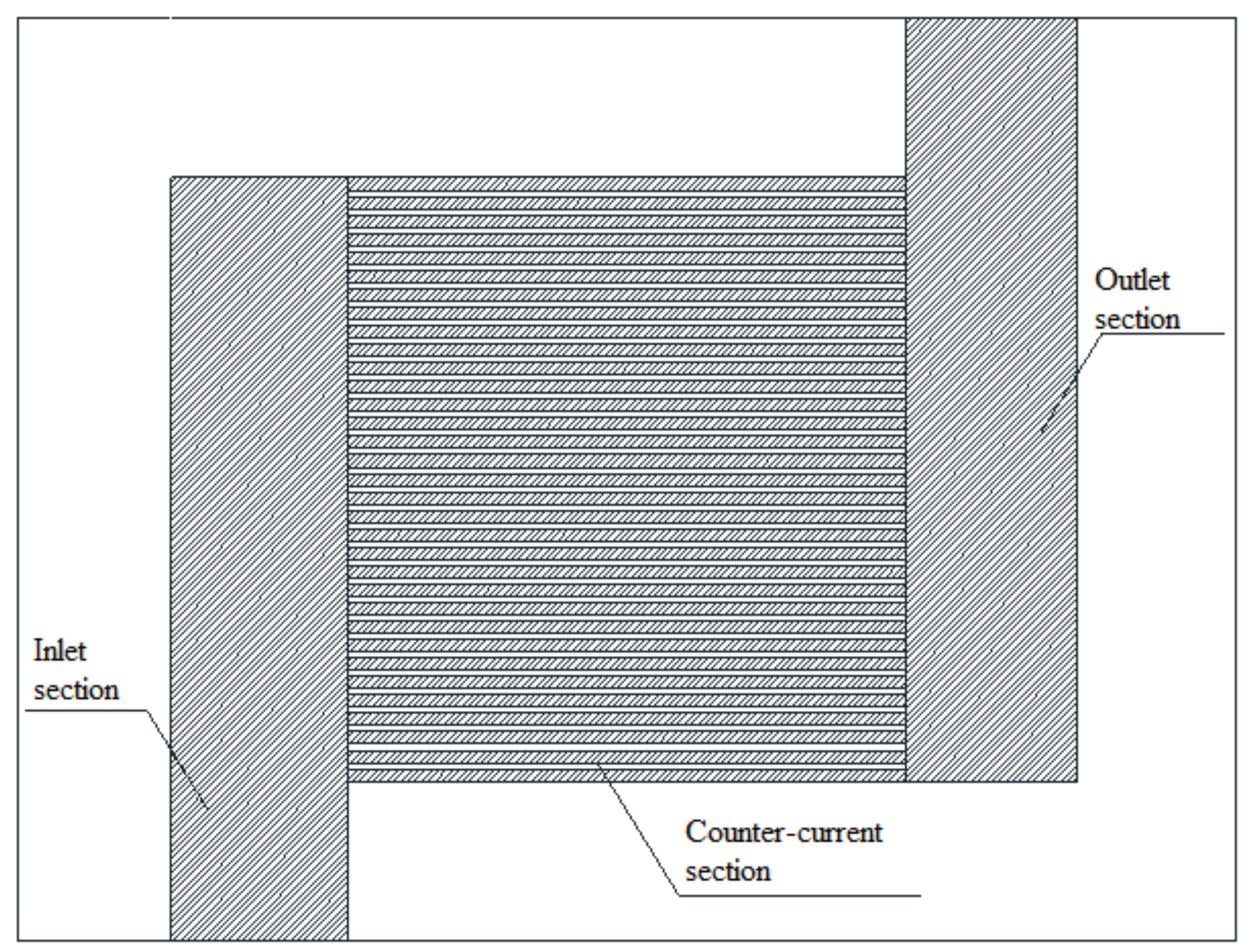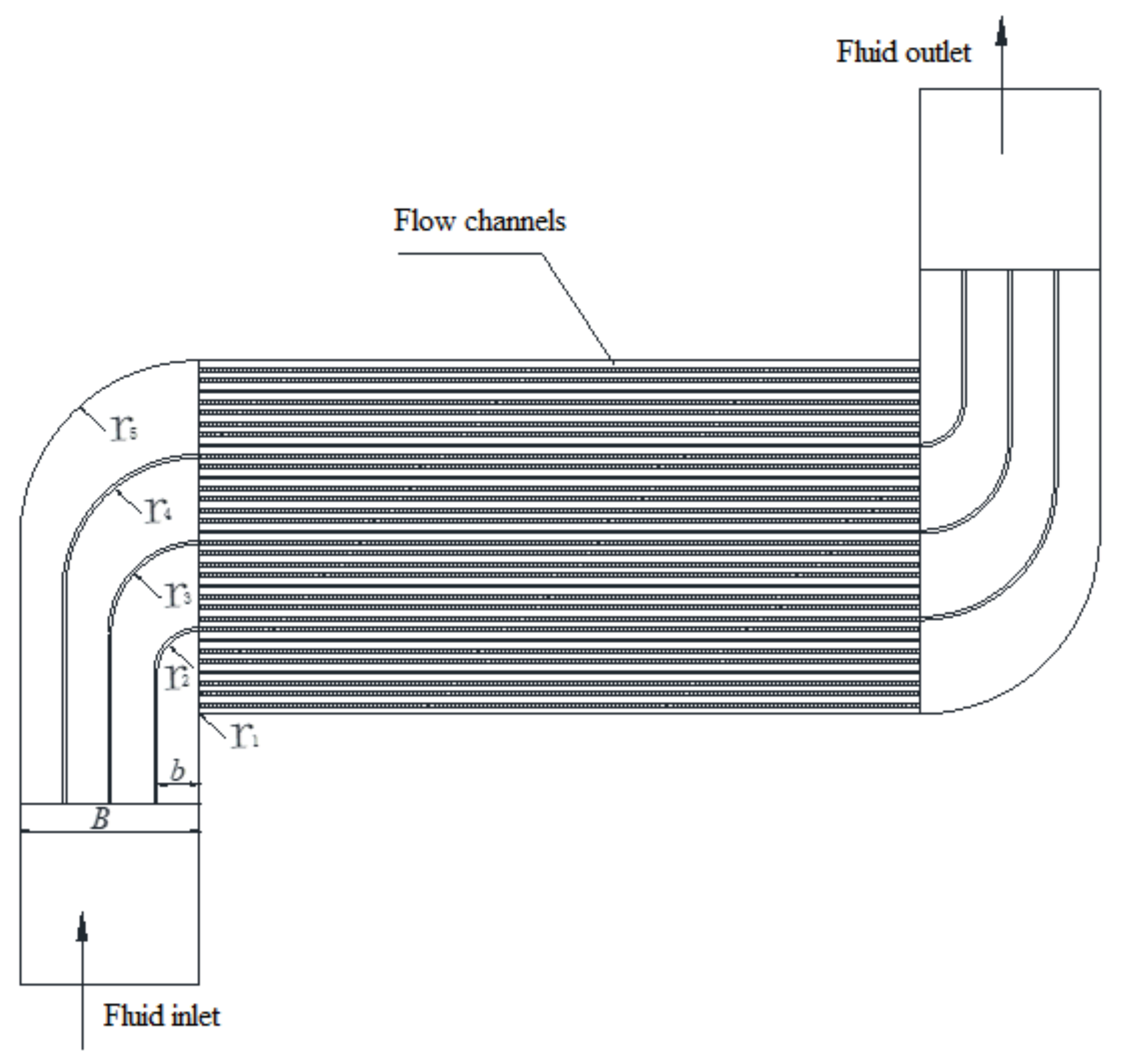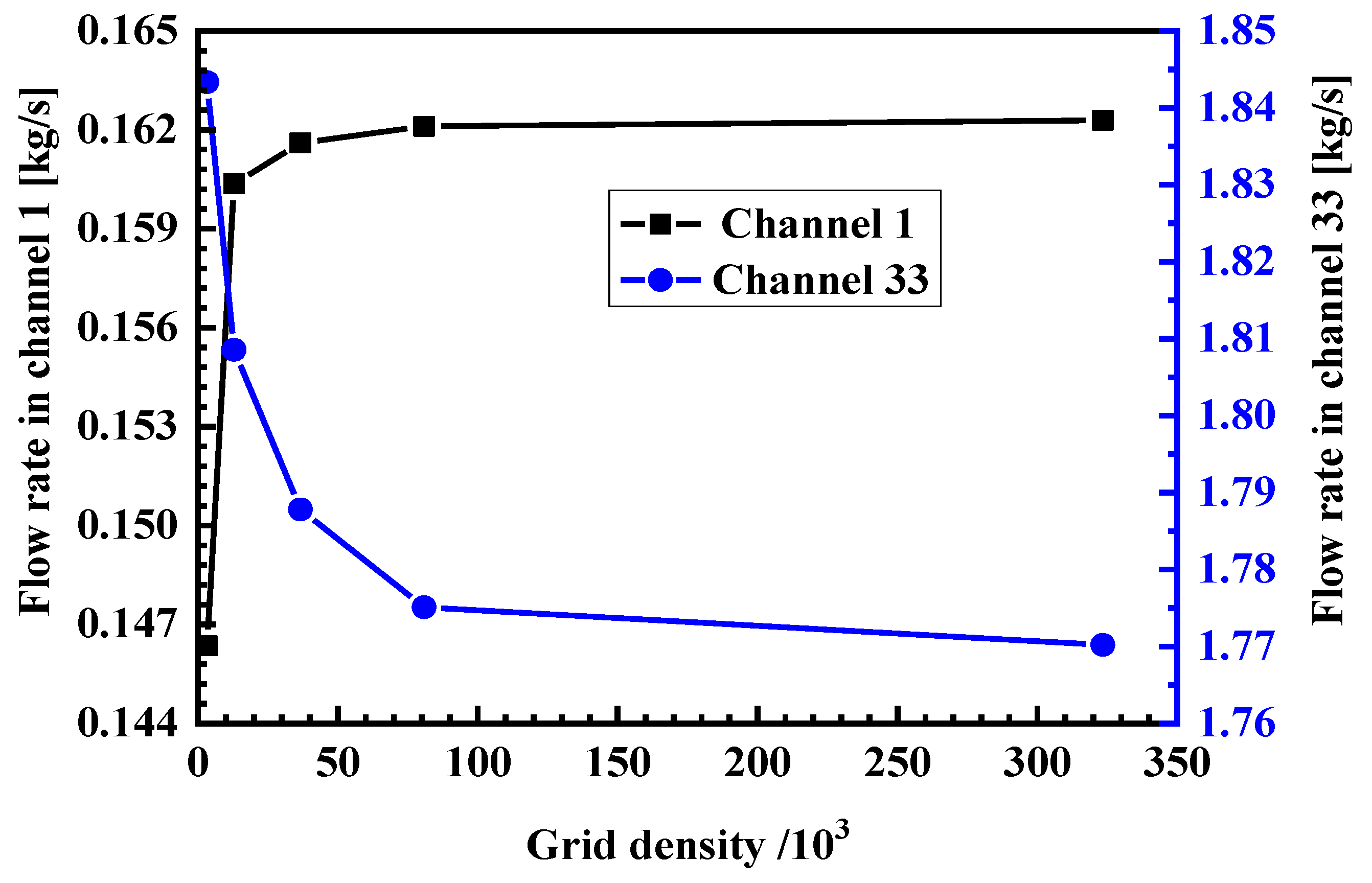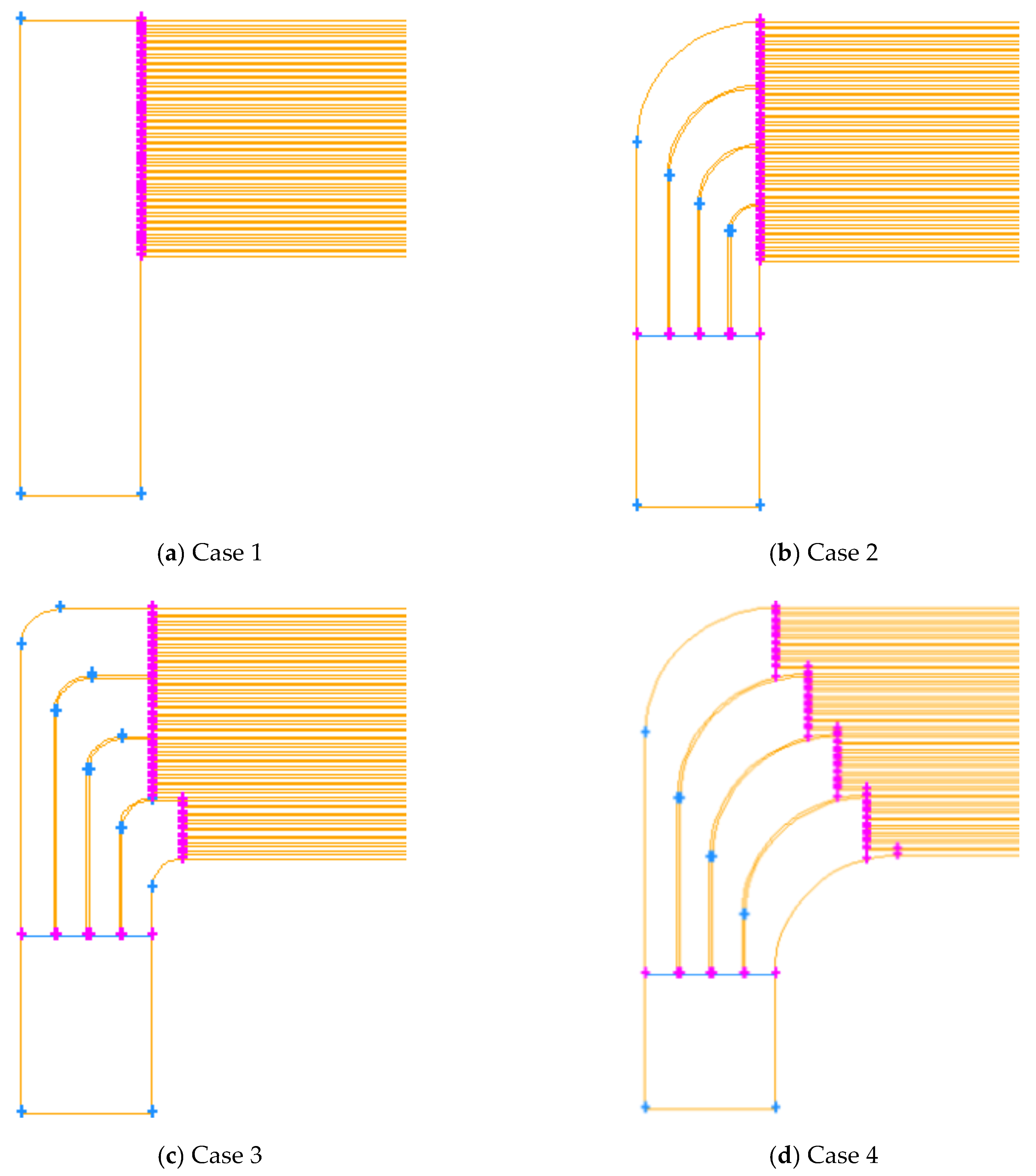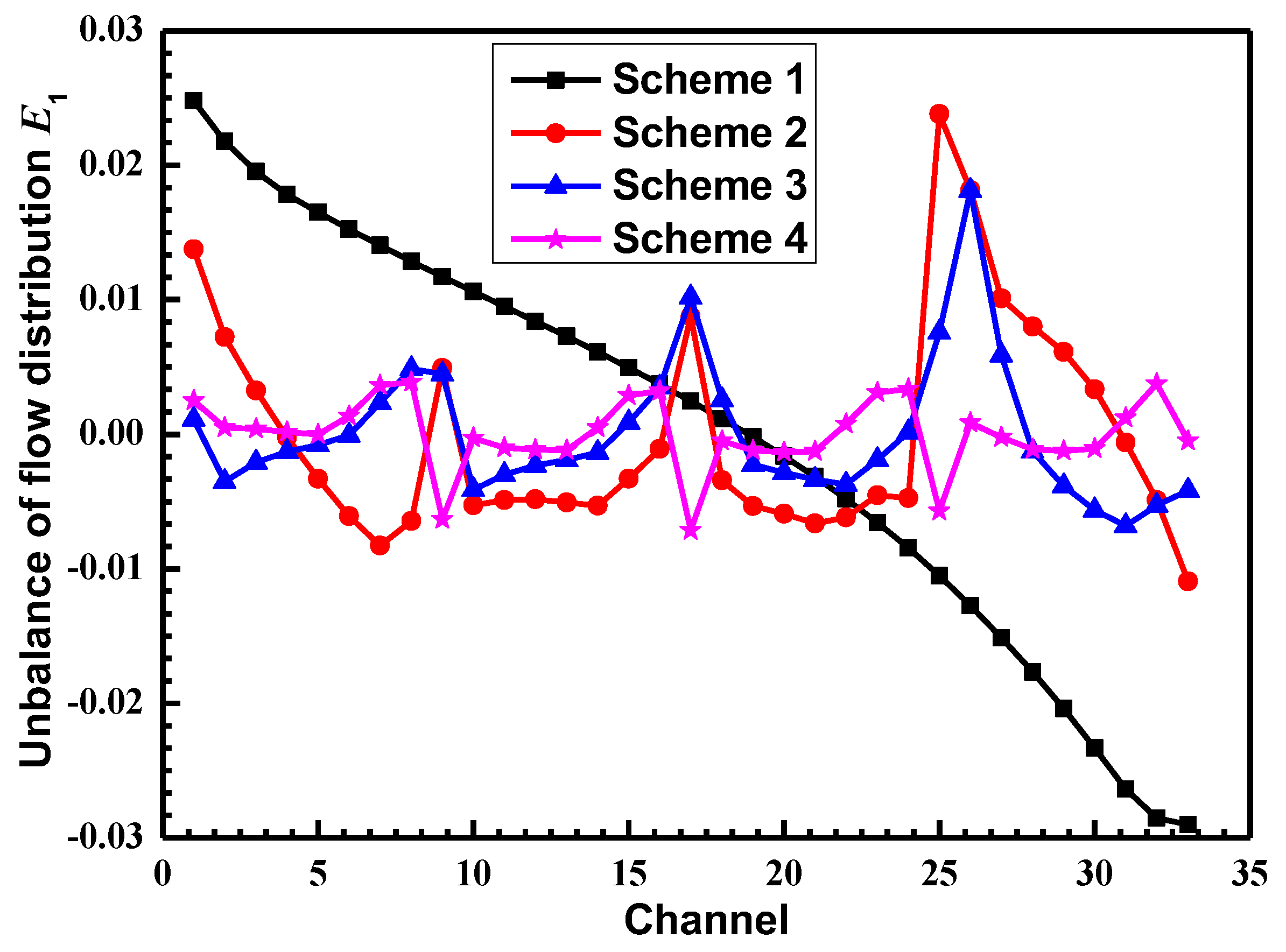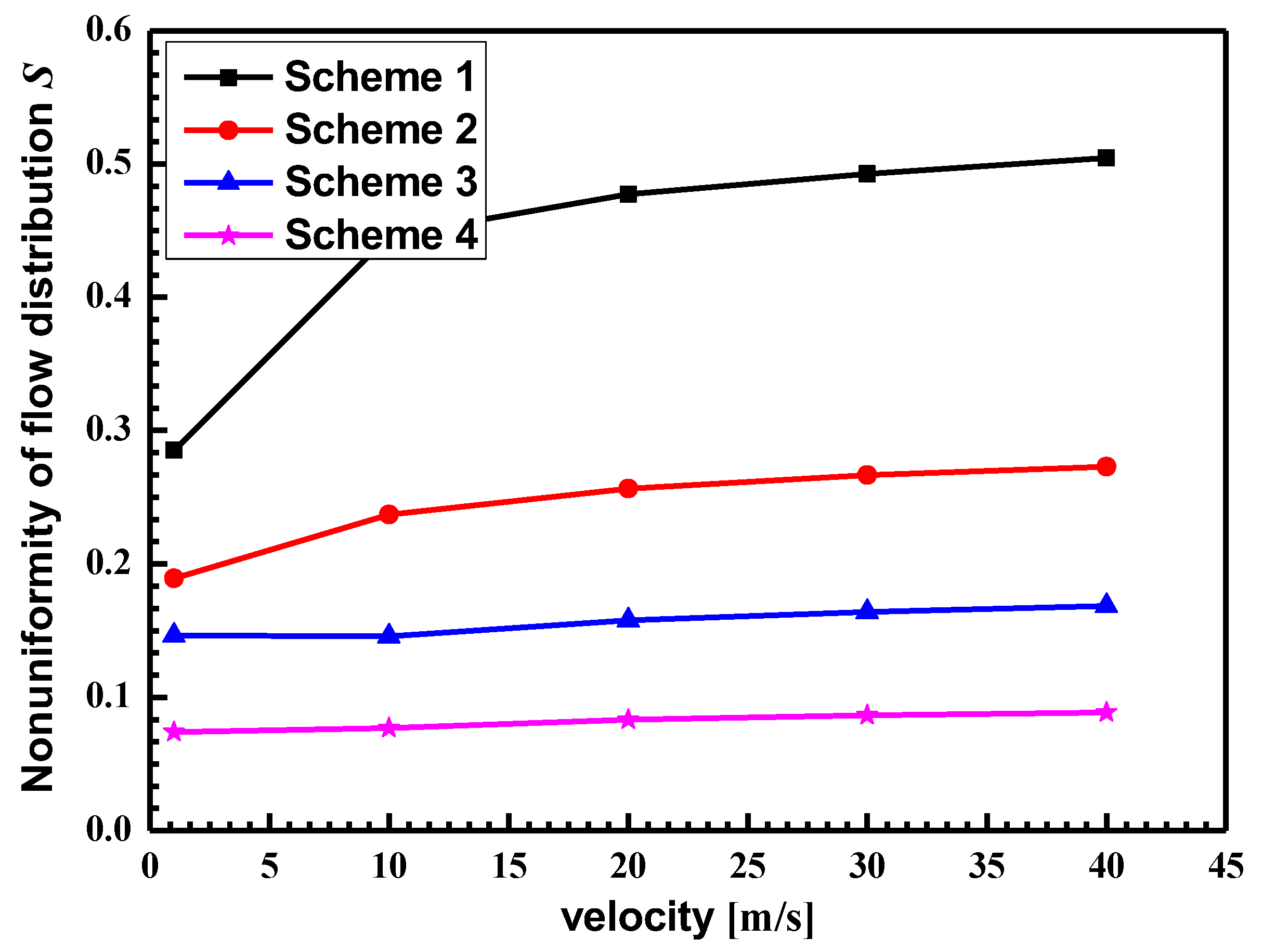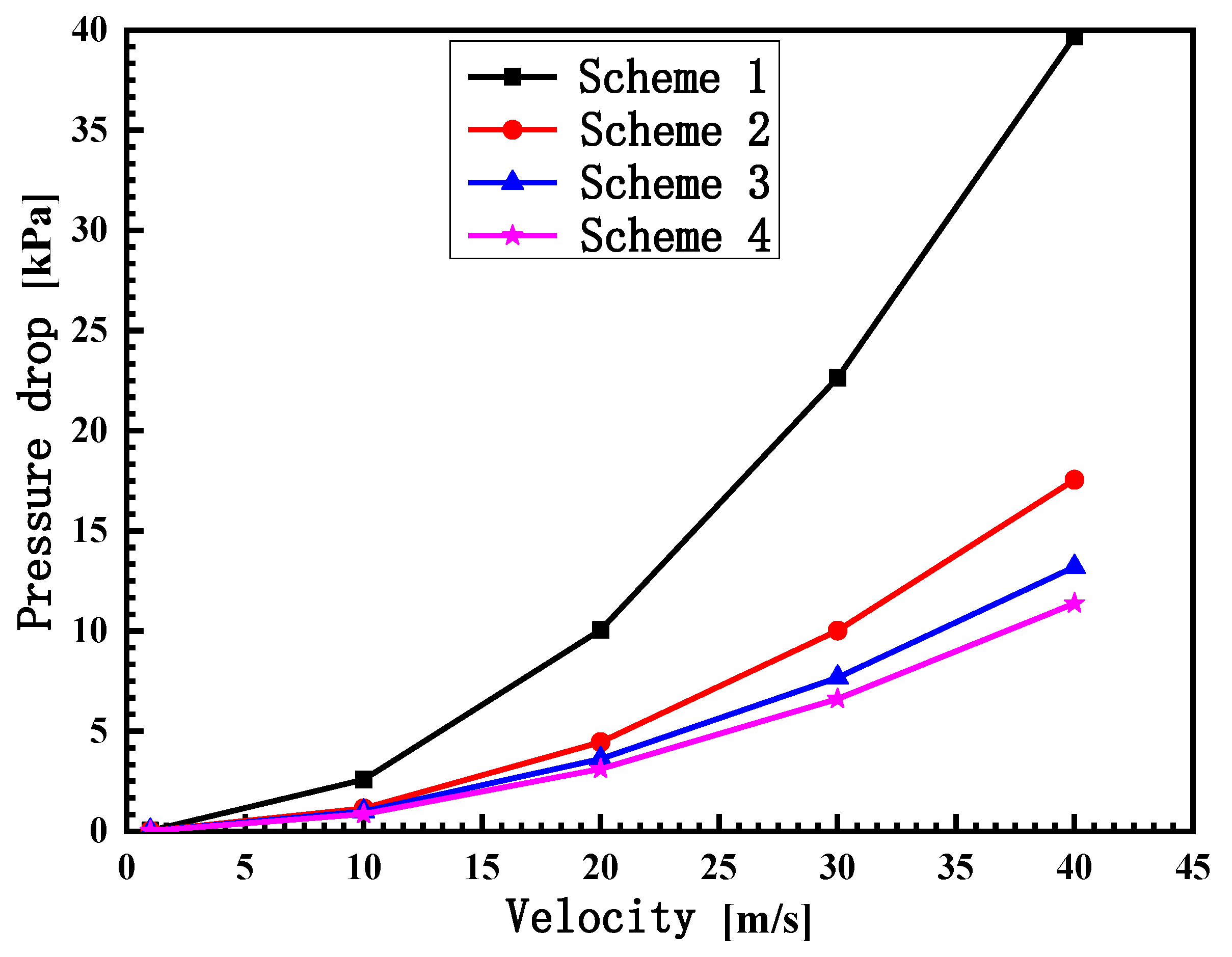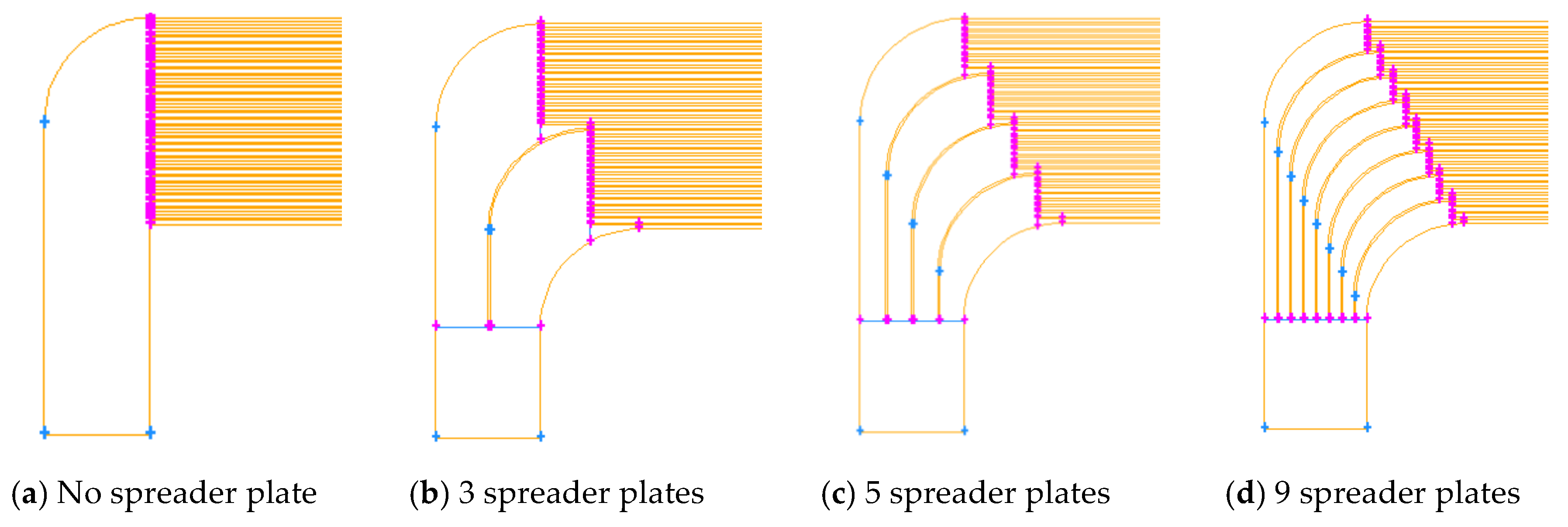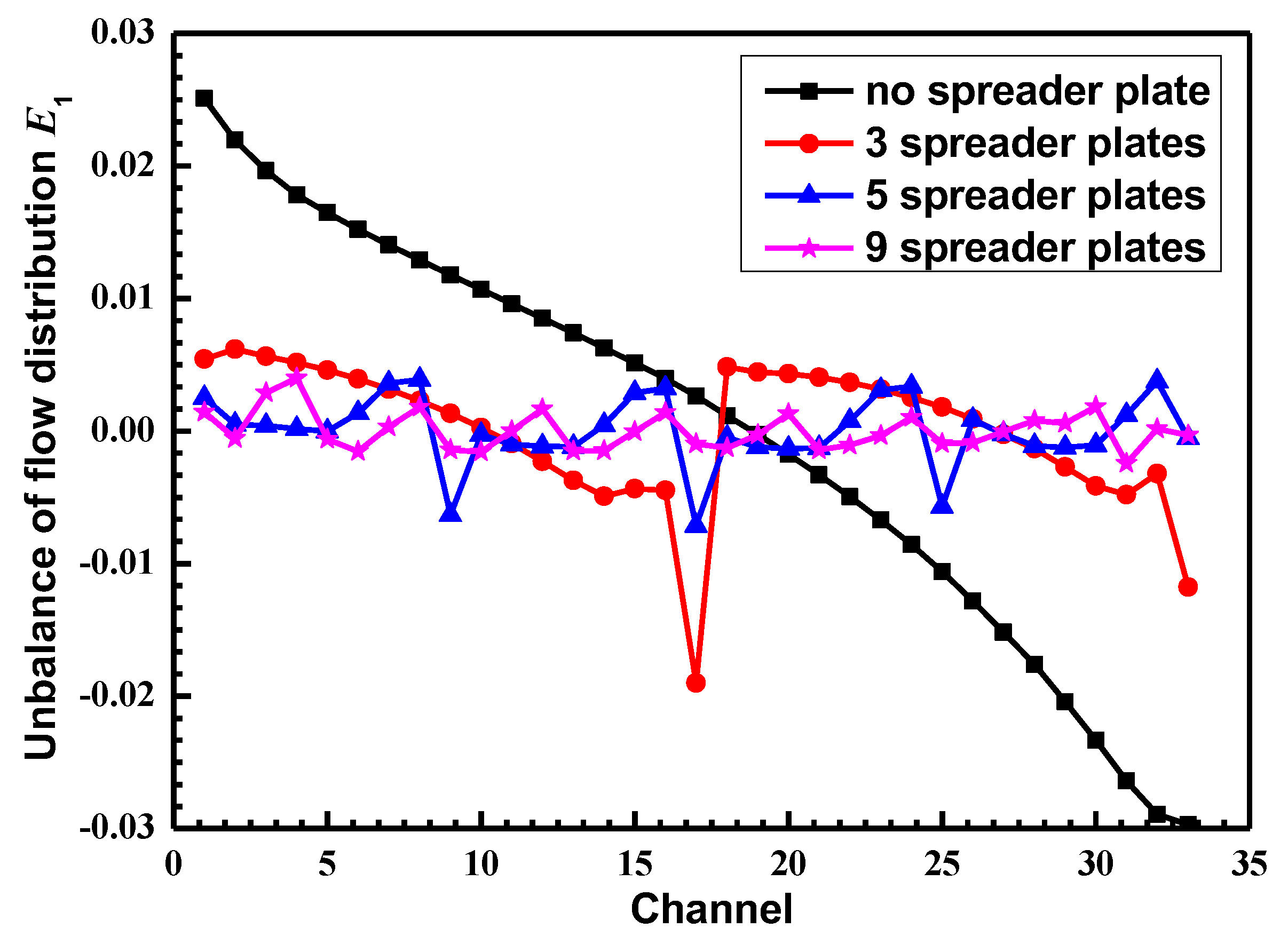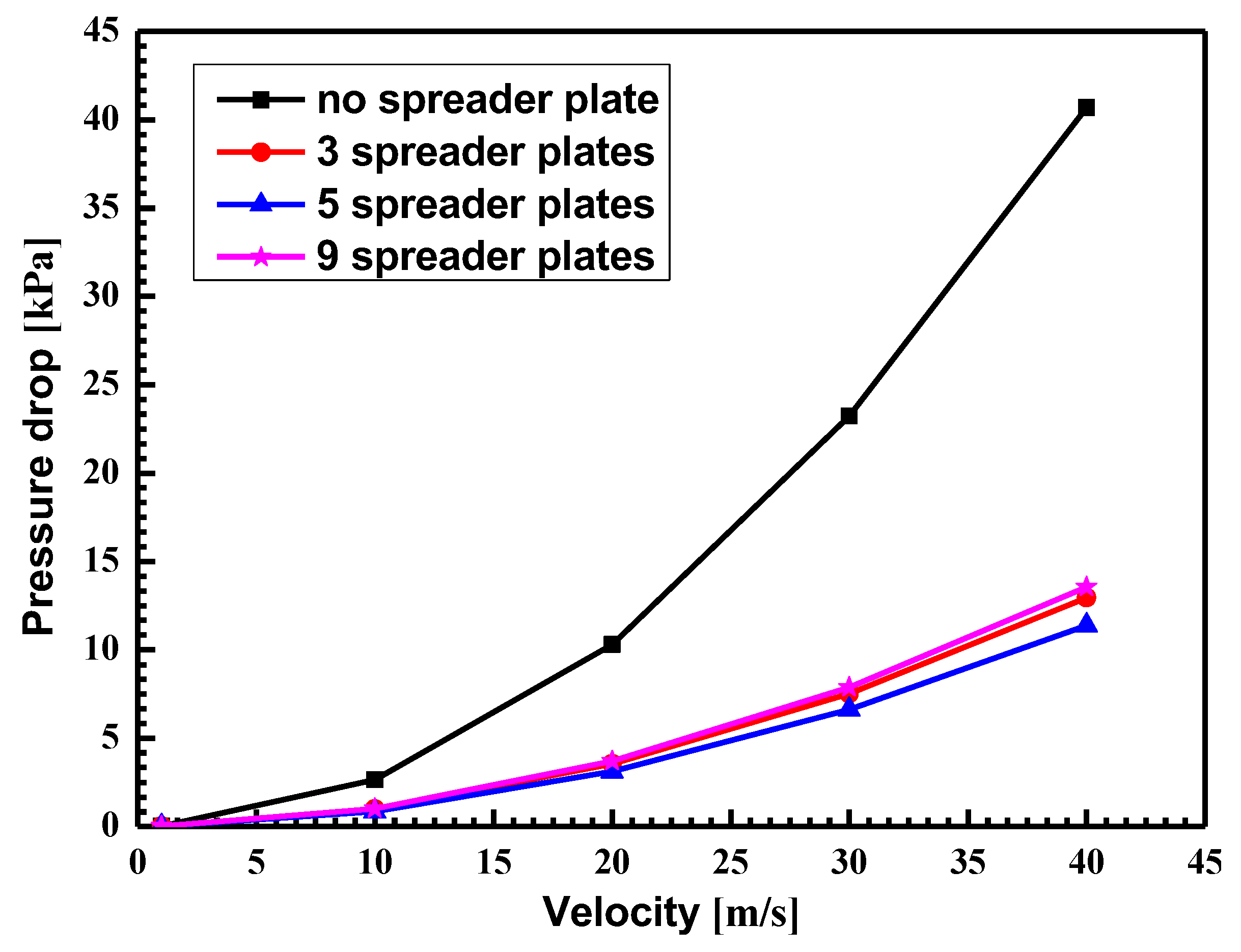1. Introduction
A heat exchanger is a device used to transfer heat from a hot fluid to a cold fluid to meet specified process requirements, which is an industrial application of convection heat transfer and heat conduction [
1]. The heat exchanger is an important piece of ship power system equipment, because the efficiency and cost of the ship power system are both significantly affected by the thermal-hydraulic performance of the intermediate heat exchanger [
2]. The ship power system has a large amount of heat generation, in which its internal high heat flux electronic equipment has a large demand for heat dissipation, so it needs to adopt efficient cooling and heat dissipation technology in a limited space. It is necessary to develop a highly efficient heat exchanger with a high temperature and high pressure for the ship power system.
Double-pipe heat exchangers are the simplest exchangers used in industry. On one hand, these heat exchangers are cheap for both design and maintenance, making them a good choice for small industries. On the other hand, their low efficiency, coupled with the large amount of space they occupy in large scales, has led modern industries to use more efficient heat exchangers, such as shell-and-tube or plate [
3]. Considering the special nature of the marine environment, the traditional shell-and-tube heat exchangers are widely used as ship heat exchangers, which highly satisfy the requirements of the power system [
4]. However, with the development of ship power systems in the direction of integration, miniaturization and high reliability, the traditional shell-and-tube heat exchanger has gradually exposed the problems of its large volume, heavy weight and high safety risk in a long-term, high-pressure environment. So, the investigation of a new compact structure and technology that possesses a high reliability of heat transfer is an inevitable developmental trend in the ship power system [
5].
As a new type of highly efficient compact heat exchanger, the printed circuit heat exchanger (PCHE) is composed of many micro-channel plates, which can be chemically etched to generate a variety of channels [
6]. Following this, the hot and cold plates are alternately superimposed with diffusion welding to create a compact heat transfer unit, which has the advantages of high-pressure resistance, heat exchange efficiency and compactness [
7].
Generally, the channel diameter of PCHE is about 0.1 to 2.0 mm and the density of the heat transfer area can be as high as 2500 m
2/m
3 [
8]. The working conditions can be different depending on the range of applications. The maximum temperature can reach 900 °C, the working pressure can reach 60 MPa and the design life can even reach 30–60 years. Under the same heat transfer power, the volume of PCHE is only about 1/5 of the shell-and-tube heat exchangers [
9]. Therefore, PCHE provides a new heat transfer method to achieve the future of the ship power system with characteristics of integration, miniaturization and high reliability.
However, due to geometry design features or operating conditions, flow maldistribution is a common problem that can significantly reduce the desired heat exchanger performance. Therefore, finding a way to improve flow uniformity in PCHEs, so as to reduce the heat exchanger size, design margins or achieve the desired production rate, is of vital importance [
10].
The effects of non-uniform flow on the heat exchanger performance have been well investigated over the decades. Jiao et al. [
11] proved that the performance of the flow distribution in the heat exchanger is effectively improved by the optimum design of the second header installation by experimental studies. The results indicate that the flow distribution becomes more uniform when the ratio of outlet pipe diameter to inlet pipe diameter of the two headers of the heat exchanger are equal. Bobbili et al. [
12] carried out experimental investigations to find the flow and pressure difference across the port to the channel in plate heat exchangers for a wide range of Reynolds numbers. The results indicated that the flow maldistribution increases with the increasing overall pressure drop in the plate heat exchangers. Zhang et al. [
13] used various distributor configurations with a plate-fin heat exchanger under different operating conditions to assess the resultant change in its flow distribution and thermal performance. The results showed that the effect of the inlet angle of distributor on the flow distribution is significant and flow maldistribution in the lateral and gross flow directions is different.
However, the experimental research has some shortcomings, such as the large number data errors and the failure to cover all heat exchanger conditions. Therefore, the numerical simulation of non-uniform flow is particularly important. Zhang et al. [
14] used the CFD method to predict the fluid flow distribution in plate-fin heat exchangers, which was simulated according to the configuration of the plate-fin heat exchanger currently used in industry. Wen et al. [
15] characterized the turbulent flow structure inside the entrance of the plate-fin heat exchanger by CFD simulation under similar conditions. The numerical results indicate that the performance of fluid maldistribution in conventional entrance deteriorated, while the improved configuration, with a punched baffle, can effectively improve the performance in both radial and axial direction. Sheik et al. [
16] performed a numerical study of the flow patterns of compact plate-fin heat exchangers because air (gas) flow maldistribution in the headers affects the exchanger performance. Three typical compact plate-fin heat exchangers were analyzed using Fluent software for the quantification of the flow maldistribution effects with ideal and real cases in their study.
When studying the pressure and flow characteristics or the heat transfer in arbitrary fluid conditions, symmetry is a necessary consideration. Wei et al. [
17] studied the pressure fluctuation and flow characteristics in a two-stage, double-suction centrifugal pump based on CFD analysis. Monitor points were arranged in the full flow channel from the inlet to the outlet of the pump in order to show all the pressure fluctuation characteristics of the pump. Due to some parts of the pump rotating, as well as the whole shape being axially symmetric, the monitor points were set to rotate with the impeller in the rotation parts. Afridi et al. [
18] carried out an irreversibility analysis of hybrid nanofluid flow over a thin needle with the effects of energy dissipation. When conducting the theoretical study of the heat transfer and entropy generation in the flow of dissipative hybrid nanofluid, the coordinate system and the geometry of the physical flow model are only shown for half of the thin needle, because of its symmetry, which simplified the calculation process of this study. Therefore, it is necessary to analyze the symmetry of the heat exchanger, including its structure central symmetry, channel flow field symmetry and adjacent channel structure symmetry.
However, the multi-channel PCHE plate shows an obvious maldistribution effect in practical applications, which produces a great limitation in the performance promotion of the PCHE plate. This aspect was rarely investigated in the available literature. To this end, this paper aims to present the flow distribution and resistance characteristics of the PCHE plate, which was studied with numerical models under different flow distribution cases; the numerical simulation of fluid flow distribution can provide guidance for subsequent research and the design and development of multi-channel heat exchangers.
2. Physical Problems and Mathematical Model
2.1. Physical Problems
Due to the limitations of the processing technology and conditions, it is difficult to process large-sized PCHEs. Presently, the use of square plates is an effective way to improve the heat transfer power of a single heat exchanger unit. However, the inlet and outlet parts occupy a large heat transfer area in the nearly square plate using the traditional single-in and single-out flow, resulting in the area of the counter-current heat transfer part in the middle being very limited, as shown in
Figure 1, and greatly influencing the heat transfer efficiency of PCHE. The use of a collecting flow in the inlet and outlet will greatly reduce the space occupied by the inlet and outlet parts which, in turn, will maximize the length of the counter-current heat transfer part, as shown in
Figure 2. The flow distribution was very inhomogeneous on the heat exchanger plate between the inlet and outlet, due to the different pressures of the different channels, which will lead to a significant decrease in the heat transfer efficiency of PCHE and an increase in the flow resistance [
19].
Therefore, the uniformity of flow distribution is a key factor affecting the performance of PCHE [
20]. In this paper, a PCHE numerical model was established. The flow distribution and resistance characteristics of a PCHE with collecting flow plates at the inlet and outlet were studied by using different flow distribution cases.
The calculation model is shown in
Figure 3, combining the existing problems, and the heat exchanger plate was set with a collecting flow at the inlet and outlet. Some spreader plates were placed in the inlet and outlet parts to improve the uniformity of flow distribution within the channels. The width between the inlet and outlet is
B, the width between spreader plates is
b, and the radius of spreader plates are
r1,
r2,
r3,
r4,
r5 respectively.
2.2. Assumptions
In order to facilitate the study of the computational model, the following assumptions must be defined:
- (1)
Flow is steady and isothermal, and fluid properties are independent of time;
- (2)
Fluid density is dependent on the local temperature only, or is treated as a constant;
- (3)
Fluid slip at the solid-fluid interfaces is neglected;
- (4)
Thermo-physical properties of fluid are independent of temperature variations;
- (5)
Body forces are caused only by gravity (i.e., magnetic, electrical, and other fields do not contribute to the body forces);
- (6)
Newtonian fluid, incompressible flow and turbulent flow.
2.3. Governing Equations
The governing equations describe the operation of fluid flow inside the channel. When the governing equations were used to directly model the flow, it was necessary to use small time and space steps to distinguish the detailed spatial structure and the time-varying temporal characteristics in turbulence. However, this requires a large amount of memory space and a very high CPU operating speed. Therefore, the direct numerical calculation of the governing equation is still difficult to use in engineering calculations. However, if the turbulence models in FLUENT (like the
k-ε model) are introduced to simplify the N-S equation, it can be applied to engineering calculations. The general form of all the governing equations in the fluid domain for the present steady-state problem is shown as follows:
It should be noted that the above equation can be used for describing the equations of continuity, momentum, turbulent dissipation rate and turbulence energy.
For the equation of continuity:
For the equations of momentum (
u,
v,
w):
For the equation of turbulent dissipation rate (
k):
For the equation of turbulence energy (
k):
In the above equations, the parameter ρ means the density of the fluid, S represents the source item; l means the characteristic length of the turbulent channel; k means the turbulence energy; ε means the turbulent dissipation rate; CD, C1, C2 means the empirical constant.
2.4. Boundary Conditions
Inlet: Velocity Inlet Boundary Condition
In the velocity inlet boundary condition, the stagnation point parameters of the inlet boundary in the flow field are not fixed. In order to satisfy the velocity condition at the inlet, the stagnation point parameter will fluctuate within a certain range.
Outlet: Outflow Outlet Boundary Condition
The boundary condition of free outflow is subject to the assumption of fully developed turbulence. Fully developed flow means that the flow field variables do not change in the flow direction, that is, the diffusion flux of all flow variables is equal to zero in the normal direction of the outlet boundary.
2.5. Numerical Details
The viscosity in the solid domain is considered infinite. The thermo-physical properties of the working fluid can be calculated based on its temperature and pressure, as shown in
Table 1. In this table, some of the permanent parameters in the numerical simulation are clearly presented, including channel type, number of channels, plate size, channel size, channel spacing, the width of the inlet and the outlet, the working fluid, pressure, and inlet velocity.
4. Conclusions
In this study, different flow distribution cases were designed and theoretically studied in order to improve the uniformity of the fluid flow distribution, and the resistance characteristics at the inlet and outlet of the PCHE channel were numerically modeled and analyzed in detail. Our conclusions can be drawn as follows:
(1) With the use of the spreader plate with an equal inner and outer radius, the sudden change in the angle of the fluid at the inlet of the channel can be greatly reduced. The flow separation of the fluid at the inlet of the channel can also be weakened and the imbalance of flow distribution in the channel can be reduced. So, the flow uniformity can be improved and the pressure loss between the inlet and outlet of the PCHE can be reduced;
(2) With the use of nine spreader plates, the imbalance of flow distribution in the channel is basically reduced to ±0.2%, and the total flow distribution is within 5%, which indicates a good flow distribution uniformity;
(3) The uniformity of the flow distribution increases with the increase in spreader plates. However, with the increase in the number of spreader plates, the flow cross-sectional area at the inlet and outlet increases, the flow velocity increases, and the pressure loss increases. Therefore, the number of spreader plates cannot increase without limitation, which should comply with the integrated uniformity of the flow distribution, flow resistance and heat transfer efficiency.
